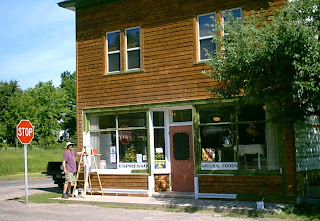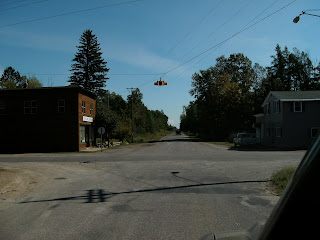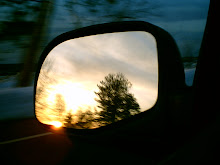Whenever I think of writing about Traunik, I begin by thinking "... in the middle of nowhere ...," and that hangs me up. Everywhere is nowhere and everywhere is somewhere—I’m beginning to see that—and so is Traunik nowhere and somewhere.
Two roads pass through Traunik, H01 and H44, and where they cross is where it is, generally speaking. Although Traunik once had its own ZIP code, it has never had boundaries. In 1927 Louis Mikulich, owner of a general store on the northeast corner of the crossroads, applied for post office status for the burgeoning area. He submitted three names, and somewhere some postal employee chose Traunik, which happens also to be the name of a village in Loski Potok, Slovenia, from where many of the area's residents had emigrated. Now it occasionally happens that folks in Slovenia spot Traunik, Michigan, on a map and come to investigate. And every July Fourth members of the Traunik Slovenian Club come back to eat sausage and potica and strudel and to polish with corn meal and polkas the aged hardwood floor of the Traunik Hall.
The Hall
"We no longer have a sense of community," Frank Bartol, 79, says as we sit at his kitchen table talking over cups of tea and fresh-baked cinnamon rolls. Frank was born in Traunik, Michigan, and has lived there most of his life. "The community exists in our history and, because we got together to preserve the Traunik Hall and create the Traunik Slovenian Club, that sense of community exists once or twice a year because people come from wherever they live to celebrate the Fourth of July."
Frank lives just a shade north of the crossroads in a tidy tan house with his wife, Judith. Go down to the crossroads, take a right, and there's the Traunik Hall, a squat, single story building with a basement, painted white with dark green trim. A large wooden deck spans the front and double-hung windows march down each side. After passing through a small entryway, one comes into a large, airy, wood paneled room—a dance hall with a raised stage at the far end. The floor is worn and shiny. An old pot-bellied stove squats laconically in a corner. Unadorned, single strand light bulbs dangle from the ceiling. Short lace curtains on the windows filter sunlight, and between the windows are photo displays, each with a theme such as "Logging," "Entertainment," "Children," and "Getting Together," each telling the story of Traunik. The smell is antiquity, slightly sweet and musty.
The hall's basement houses a utilitarian kitchen with long rows of folding tables and chairs, painted concrete walls, log pillars (to stabilize the dance floor), and a concrete floor. At the far end an American flag hangs beneath an old whitewashed wooden sign that proclaims in big black block letters: Traunik.
From the start, the hall, built in 1922 as Lodge 387 of the Slovenian National Benefit Society, has been a place for celebrations, playing host to weddings, anniversaries, reunions, as well as Fourth of July festivities. Even when the society dwindled after World War II and the hall eventually was bought by a local family, it was rented out for special occasions. Then, in 1993, Frank acted on an idea. He sent a letter to 150 or so Slovenians with Traunik roots who now lived elsewhere. In the letter he outlined plans to create the Traunik Slovenian Club and asked for financial pledges to raise money to buy the Traunik Hall. Within a month, he says, enough money came in to buy the hall and, as well, to set up a maintenance fund.
The hall was dedicated on July 4, 1993, with Frank's father, also named Frank and 98 at the time, unveiling a boulder on which a plaque had been affixed. It reads:
The Schoolhouse
Frank showed me the hall that day, after our tea and rolls, and pointed out the schoolhouse next door, which we had talked about also, as it is the second of three buildings in Traunik built more than 80 years ago and still in use today, each honoring its intent. The school, now a Head Start Center, is a modest building with a black, hipped roof topped with a cupola that protects the school bell. Frank attended the two-room school from 1935 to 1942, and he recalls how the bell used to ring four times a day; now, not so often, but still, once in a while. He delights in hearing the same clanging tone that he heard as a boy and telling the story of how he saved the bell, a few years back, when the roof needed fixing and the contractor suggested removing the belfry to simplify the job. Frank wouldn't hear of it, and the roof, cupola, and bell are in their best shape ever.
In 2007 Frank wrote "Still Sits the Schoolhouse by the Road," a book about the school and his years there. He published the book on his own, as many writers do. Frank was an English teacher for more than 30 years, he has written sections included in local history books, and, for a while, he wrote a twice-weekly column that appeared in two daily Upper Peninsula newspapers. He subsequently adapted those columns into two books. He likes writing, he says, but "I never sold myself as a writer. I never tried to peddle it."
It is here, I think, that distraction was kindled, a distraction in my mind that all these months helped to hinder my writing of this story. I was going to write it as an historical piece centered on the general store, which is now called Lily's, and which is how I first came to know Traunik. I stopped at Lily's one day after strawberry picking in nearby Trenary, and Jeff, one of the owners, began relating to me a history and a present day story that caught my interest and brought to mind: "... in the middle of nowhere ...." I wanted to write the story, thought I could sell it, and thus began framing it, imagining an audience, an audience that would be intrigued by history, happenstance, hard work, and faith.
"I hate selling," Frank says, "but I like writing." I tell him I understand, for I feel the same way. He goes on to say he doesn't understand why a writer's work is presumed to be in need of alteration by others when the work of other artists and crafters is not. Imagine a painter, he says, selling a painting and then seeing it later, hanging somewhere, and perhaps a tree has been added or removed. It sounds absurd, because it wouldn't happen; paintings are not edited. Frank's newspaper columns were edited, of course, and he says, "It wasn’t my writing anymore."
Over the past few months I have thought about this, with Frank's words—"It wasn’t my writing anymore"—jostling around in my head. One morning they conjured up a picture. I saw a street musician, just a person with an instrument and a song, standing on a curb somewhere, the world rushing by, the occasional coin flipping through the air, glinting in the sunlight, landing in a hat in the middle of nowhere.
Coming soon … Traunik Part II: The General Store
Two roads pass through Traunik, H01 and H44, and where they cross is where it is, generally speaking. Although Traunik once had its own ZIP code, it has never had boundaries. In 1927 Louis Mikulich, owner of a general store on the northeast corner of the crossroads, applied for post office status for the burgeoning area. He submitted three names, and somewhere some postal employee chose Traunik, which happens also to be the name of a village in Loski Potok, Slovenia, from where many of the area's residents had emigrated. Now it occasionally happens that folks in Slovenia spot Traunik, Michigan, on a map and come to investigate. And every July Fourth members of the Traunik Slovenian Club come back to eat sausage and potica and strudel and to polish with corn meal and polkas the aged hardwood floor of the Traunik Hall.
The Hall
"We no longer have a sense of community," Frank Bartol, 79, says as we sit at his kitchen table talking over cups of tea and fresh-baked cinnamon rolls. Frank was born in Traunik, Michigan, and has lived there most of his life. "The community exists in our history and, because we got together to preserve the Traunik Hall and create the Traunik Slovenian Club, that sense of community exists once or twice a year because people come from wherever they live to celebrate the Fourth of July."
Frank lives just a shade north of the crossroads in a tidy tan house with his wife, Judith. Go down to the crossroads, take a right, and there's the Traunik Hall, a squat, single story building with a basement, painted white with dark green trim. A large wooden deck spans the front and double-hung windows march down each side. After passing through a small entryway, one comes into a large, airy, wood paneled room—a dance hall with a raised stage at the far end. The floor is worn and shiny. An old pot-bellied stove squats laconically in a corner. Unadorned, single strand light bulbs dangle from the ceiling. Short lace curtains on the windows filter sunlight, and between the windows are photo displays, each with a theme such as "Logging," "Entertainment," "Children," and "Getting Together," each telling the story of Traunik. The smell is antiquity, slightly sweet and musty.
The hall's basement houses a utilitarian kitchen with long rows of folding tables and chairs, painted concrete walls, log pillars (to stabilize the dance floor), and a concrete floor. At the far end an American flag hangs beneath an old whitewashed wooden sign that proclaims in big black block letters: Traunik.
From the start, the hall, built in 1922 as Lodge 387 of the Slovenian National Benefit Society, has been a place for celebrations, playing host to weddings, anniversaries, reunions, as well as Fourth of July festivities. Even when the society dwindled after World War II and the hall eventually was bought by a local family, it was rented out for special occasions. Then, in 1993, Frank acted on an idea. He sent a letter to 150 or so Slovenians with Traunik roots who now lived elsewhere. In the letter he outlined plans to create the Traunik Slovenian Club and asked for financial pledges to raise money to buy the Traunik Hall. Within a month, he says, enough money came in to buy the hall and, as well, to set up a maintenance fund.
The hall was dedicated on July 4, 1993, with Frank's father, also named Frank and 98 at the time, unveiling a boulder on which a plaque had been affixed. It reads:
To this place they came, beginning in 1912, and when enough had come to form a community, they named it Traunik, which means "meadow" in Slovenia, the country they left behind in search of a better life.The younger Frank wrote the dedication. Now he's one of two locals who maintain the hall, a key holder, so to speak, but no official title. "It's a club in name only," he says, as there are no by-laws, no officers, just an annual newsletter and the Fourth of July dance. As many as 200 may gather for that event, though once, in 2000, there were as many as 400 revelers polishing the old wood floor, including the mayor of Loski Potok, whom Frank had invited as a special guest in honor of the millennium. As always, others may use the hall, but one gets the feeling it's the Slovenians' soles that keep the floor gleaming.
They brought with them a willingness to work and a desire to succeed, and out of the forest they shaped fields, homes, and a good life for their families.
This memorial is dedicated to them by their children and grandchildren, now scattered about the world but tied by invisible bonds to this spot, where once the night air was filled with Slovenian melodies, and an ethnic community pulsed with life.
The Schoolhouse
Frank showed me the hall that day, after our tea and rolls, and pointed out the schoolhouse next door, which we had talked about also, as it is the second of three buildings in Traunik built more than 80 years ago and still in use today, each honoring its intent. The school, now a Head Start Center, is a modest building with a black, hipped roof topped with a cupola that protects the school bell. Frank attended the two-room school from 1935 to 1942, and he recalls how the bell used to ring four times a day; now, not so often, but still, once in a while. He delights in hearing the same clanging tone that he heard as a boy and telling the story of how he saved the bell, a few years back, when the roof needed fixing and the contractor suggested removing the belfry to simplify the job. Frank wouldn't hear of it, and the roof, cupola, and bell are in their best shape ever.
In 2007 Frank wrote "Still Sits the Schoolhouse by the Road," a book about the school and his years there. He published the book on his own, as many writers do. Frank was an English teacher for more than 30 years, he has written sections included in local history books, and, for a while, he wrote a twice-weekly column that appeared in two daily Upper Peninsula newspapers. He subsequently adapted those columns into two books. He likes writing, he says, but "I never sold myself as a writer. I never tried to peddle it."
It is here, I think, that distraction was kindled, a distraction in my mind that all these months helped to hinder my writing of this story. I was going to write it as an historical piece centered on the general store, which is now called Lily's, and which is how I first came to know Traunik. I stopped at Lily's one day after strawberry picking in nearby Trenary, and Jeff, one of the owners, began relating to me a history and a present day story that caught my interest and brought to mind: "... in the middle of nowhere ...." I wanted to write the story, thought I could sell it, and thus began framing it, imagining an audience, an audience that would be intrigued by history, happenstance, hard work, and faith.
"I hate selling," Frank says, "but I like writing." I tell him I understand, for I feel the same way. He goes on to say he doesn't understand why a writer's work is presumed to be in need of alteration by others when the work of other artists and crafters is not. Imagine a painter, he says, selling a painting and then seeing it later, hanging somewhere, and perhaps a tree has been added or removed. It sounds absurd, because it wouldn't happen; paintings are not edited. Frank's newspaper columns were edited, of course, and he says, "It wasn’t my writing anymore."
Over the past few months I have thought about this, with Frank's words—"It wasn’t my writing anymore"—jostling around in my head. One morning they conjured up a picture. I saw a street musician, just a person with an instrument and a song, standing on a curb somewhere, the world rushing by, the occasional coin flipping through the air, glinting in the sunlight, landing in a hat in the middle of nowhere.
Coming soon … Traunik Part II: The General Store





